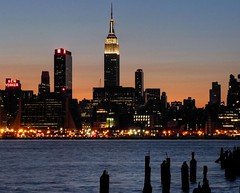Realtors report the national median existing-home price was $187,300 in July, up 9.4% from a year ago. At the same time new homes are getting hard to come by, with just 4.6 months of supply on the market–down from a 14.3-month peak in January 2009.
With historically low mortgage rates and housing prices still 31% below their bubble highs, the residential real estate recovery likely has more room to run. Meanwhile, the improving economy is also making commercial real estate attractive.
Toll Brothers (TOL, 32), known for homes priced at $500,000 and up, is benefiting from its well-heeled clientele’s ability to borrow at ultralow rates.
I like Toll Brothers’ strategic diversification away from single-family suburban homes; it has been investing in upscale urban markets like New York City, where it developed condos in Brooklyn and Manhattan even during the bust.
| New York City Serenade (Photo credit: joiseyshowaa) |
NVR (NVR, 820), based in Reston, Va., is another builder on the comeback trail. It focuses on suburban markets around Washington, D.C., where home affordability is luring young renters into buying before interest rates jump. NVR’s earnings this year are forecast to rise 43%, with sales up 18%.
Both NVR and Toll are concentrated in geographic markets where job growth has been ahead of the national average. Employment dynamos like Seattle and Austin are bright spots for housing and also for commercial landlords. Several publicly traded real estate investment trusts are buying up properties at cheap valuations in cities where technology jobs tend to cluster.
Seattle continues to flex its tech muscle, and REITs, in pursuit of rising property values and rental rates, continue to invest in income-producing properties there.
I like Kilroy Realty (KRC, 47). It focuses on “knowledge-worker” office space all along the West Coast, with heavy concentrations on Los Angeles’ Westside and in Silicon Valley. Earlier this year Kilroy laid out more than $330 million for three prime Seattle office properties, including one fully leased to Adobe Systems and other computer software makers.
Kilroy morphed from a family-owned enterprise into a public company in the mid-1990s and now has an equity market capitalization of $3.3 billion. Its 3% yield may put off some income-hungry investors, but Kilroy has shown it can grow even in a weak economy and has good strategic focus, with a dominant position in its geographic centers. Revenue is expected to increase 19% this year.
CommonWealth REIT (CWH, 15) is a small-cap property owner offering a fat 13% yield. It buys high-quality office buildings like Capitol Tower in Austin, Tex., which it picked up in May for $49 million fully leased at an 8.4% capitalization rate, according to Real Capital Analytics. Revenue this year is forecast to grow 12%.
One REIT whose stock price has broken out of a long-term holding pattern and begun moving north is well positioned to take advantage of any green shoots that push to the surface in a recovery. PS Business Parks (PSB, 68) focuses on small tenants, often entrepreneurs, in spaces smaller than 5,000 square feet, heavily but not–exclusively in the Southeast–the kind of properties that thrive as startups get a foothold during a recovery.
Revenues for PSB, which is affiliated with self-storage giant Public Storage (PSA), should be up 15% this year. The yield is a modest 2.6%, but the total return potential is substantial for this lightly leveraged office landlord.
By Peter Slatin
Taken from: http://www.forbes.com/sites/investor/2012/09/05/five-builders-and-reits-for-real-estates-rebound/






No comments:
Post a Comment